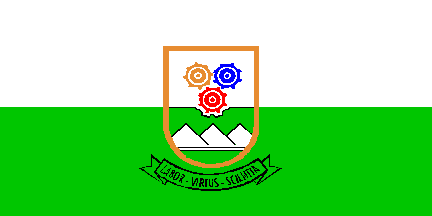
image by Dov Gutterman, 18 April 2003

Last modified: 2006-03-04 by dov gutterman
Keywords: colombia | universities |
Links: FOTW homepage |
search |
disclaimer and copyright |
write us |
mirrors
See Also:

image by Dov Gutterman, 18 April 2003
Image based on <www.tdea.edu.co>.
Dov Gutterman, 18 April 2003

image by Ivan Sache, 9 January 2004
The Escuela was founded in 1944. Its flag is horizontally
divided white-green (2:1).
Source: <www.voluntad.com.co>,
located by Dov Gutterman.
Ivan Sache, 9 January 2004

image by Ivan Sache, 8 January 2004
The Escuela was founded in Lorica (department of Cordoba) in
1940. Its flag is horizontally divided white-brown.
Source: <www.voluntad.com.co>,
located by Dov Gutterman.
Ivan Sache, 8 January 2004
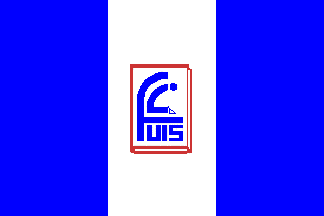
image by Ivan Sache, 10 January 2004
The College was founded in 1970 in Santander. Its flag is
vertically divided blue-white-blue with the emblem of the FUIS in
the middle. The emblem is made of a white book with a red border,
on which is placed the logo of the FUIS in blue. The logo is
based on the letters FUIS and shows a student bent over his work.
Source: <www.voluntad.com.co>,
located by Dov Gutterman.
Ivan Sache, 10 January 2004

image by Ivan Sache, 25 December 2002
Fundacio'n Escuela Superior Profesional INPAHU was funded in
1974 by Resolution 330 of the Secreatary of Education of the
Special District. Its name was then Institucio'n para el
Desarrollo Humano (Institute for the Human Development). In 1977,
Resolution 148 of the Secreatary of Education of the Special
District changed its name to Escuela Superior de Carreras
Intermedias INPAHU. On 9 October 1981, the Institute current name
was approved by Resolution 16971 of Minister of National
Education.
The flag of the Institute is an orange field with the emblem of
the Institute in the middle. Orange was selected as the result of
mixing red and yellow, red symbolizing love, energy and strength,
whereas yellow symboizes wealth, greatness and life.
The emblem of the Institute is made of three black rings slightly
excentered. In the middle of the rings is a stylized human being,
in black, too. INPAHU is written in black capital letters below
the rings. When applied on the flag, the emblem lacks the
writings.
Source: <www.inpahu.edu.co>,
located by Dov Gutterman.
Ivan Sache, 25 December 2002

image by Dov Gutterman, 21 July 2002
Image based on <www.uniboyaca.edu.co>.
Dov Gutterman, 21 July 2002

image by Ivan Sache, 16 Febuary 2004
The Fundacion Universitaria de Popayan was established in 1982
in Popayan. The grounds of the foundation were destroyed by the
earthquake of 31 March 1983. New grounds were inaugurated on 1
August 1983. The Foundation manages a botanical garden dedicated
to biodiversity preservation, ethnobotany and germplasn
conservation. The garden is a membher of the national networks of
botanical gardens, prescribed by law #229 in 1996.
The flag of the FUP is horizontally divided in three equal
stripes, whose colours cannot be ascertained from the source
quoted below. For the attached image, I have selected a
grey-green upper stripe and a dark blue lower stripe, but these
shades need to be confirmed (or corrected).
Source: <www.fup.edu.co>,
located by Dov Gutterman.
Ivan Sache, 16 Febuary 2004

image by Ivan Sache, 10 January 2004
The College is located in Giron, Santander department. Its
flag is horizontally divided yellow-green with the College emblem
in the middle.
Source: <www.voluntad.com.co>,
located by Dov Gutterman.
Ivan Sache, 10 January 2004

image by Ivan Sache, 10 January 2004
The College was founded in Valle del Lily in 1974. Its flag is
blue with a pink diamond in the middle, touching the upper and
lower borders of the flag and flanked by two smaller green
diamons touching the left and right borders of the flag,
respectively. A blck logo made of a combination of the G and F
letters is placed in the pink diamond
Source: <www.voluntad.com.co>,
located by Dov Gutterman.
Ivan Sache, 10 January 2004
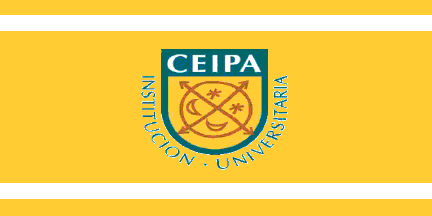
image by Ivan Sache, 14 Febuary 2004
CEIPA is the 'Centro de Investigacion y Planeamiento
Administrativo'. It was founded in Medellin in 1972 by Antonio
Mazo Mejia and his wife. In 1992, the CEIPA was granted the
status of Universitary Foundation.
The flag of CEIPA is yellow, for excellence, with two thin white
stripes, for transparency required for excellence in business, in
the upper and lower parts of the flag, and the shield of the
institute in the middle.
The shield of CEIPA is U-shaped, for University. The symbol
placed on the shield was used in the Middle Ages by merchants.
The four arrows symbolize the four compass directions, in which
commerce should spread, whereas the moon crescents and stars are
symbols of business. This medieval symbol was selected to recall
that both business and university concepts date back to the
Middle Ages.
Source: <virtual.ceipa.edu.co>,
located by Dov Gutterman.
Ivan Sache, 14 Febuary 2004
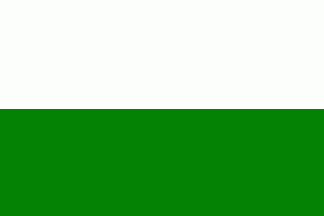
image by Jairo Alonso Méndez Méndez, 14 November 2004
Instituto Universitario de Caldas (Manizales, Caldas).
Jairo Alonso Méndez Méndez, 14 November 2004

image by Ivan Sache, 14 Febuary 2004
IUE is 'Institucion Universitaria de Envigado'. Its flag is
horizontally divided orange-white-green with the emblem of the
Institute in the middle of the white stripe. Orange and green are
the municipal colours of Envigado
(Antioquia).
Source: <iue.edu.co>,
located by Dov Gutterman.
Ivan Sache, 14 Febuary 2004
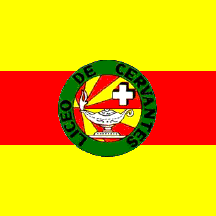
image by Ivan Sache, 9 January 2004
The flag of the College is square, horizontally divded
yellow-red-yellow, with the emblem of the college in the middle.
Source: <www.voluntad.com.co>,
located by Dov Gutterman.
Ivan Sache, 9 January 2004
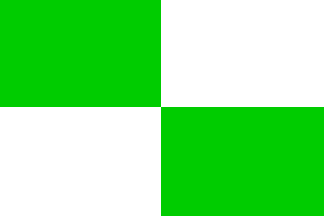
image by Ivan Sache, 8 January 2004
The Liceo was funded in Cordoba in 1953. Its flag is quartered
green-white.
Source: <www.voluntad.com.co>,
located by Dov Gutterman.
Ivan Sache, 8 January 2004

image by Ivan Sache, 14 Febuary 2004
The 'Fundacion Universitaria Los Libertadores' was founded in
Bogota in 1982. Its flag is horizontally divided green-white-red
with the emblem of the Institute in the middle of the white
stripe. The emblem is made of the heads of the three
'Libertadores', who are: 'El Libertador', Simon Bolivar; 'El
Hombre de las Leyas', Francisco de Paula Santander; 'El Precurso
de la Independencia', Antonio Nariño. The heads are surrounded
by a laurel wreath.
Source: <www.ulibertadores.edu.co>,
located by Dov Gutterman.
Ivan Sache, 14 Febuary 2004
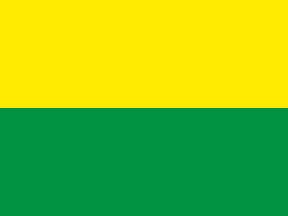
image by Eugene Ipavec, 20 February 2006
Some background from the university website:
"The Colombian Polytechnic Jaime Isaza Cadavid is a Public
University Institution, funded by the departmental government of
Antioquia. Founded in 1964, the Polytechnic now caters for
approximately 13,200 students. The main campus is situated
in El Poblado, in the city of Medellín, and counts on 1,300
educational and 350 administrative staff, as well as its
three academic centers in other municipalities of the department
of Antioquia.
The Polytechnic is a national leader in technological education
and at present offers higher education at technological,
technical and academic levels with a range of pregraduate and
postgraduate courses in areas such as Engineering,
Administration, Agrarian Sciences, Audiovisual Communication,
Sport and Recreation. These programs are supplemented by various
extension, continued education and informal courses available to
the general public."
"Poli" is named after Jaime Isaza Cadavid (1919-1965).
Cadavid studied in the Faculty of Law of the University of
Antioquia. He had liberal leanings and was elected Deputy at the
Departmental Assembly of Antioquia, (Municipal?) Councillor in
Fredonia and Antioquia, Deputy at the Chamber and Senator of the
Republic. He served as Dean and Professor ad Honorem in the
Facukty of Law of the University of Medellin. He significantly
contributed to the foundation of "Poli"; by Order 11 of
30 November 1965, his name was given to "Poli" as a
posthumous tribute.
The flag of "Poli" recalls the shield of the
University, which is per fess or and vert with additional
charges. Or/yellow symbolizes "pujanza" (pugnacity?) of
the students whereas Vert/green symbolizes hope and confidence in
the future.
Source: <www.politecnicojic.edu.co>,
located by Valentin Poposki, 18 February 2006.
Ivan Sache, 25 February 2006.

image by Carlos Thompson, 27 May 2003
"Pontificia Universidad Javeriana" is a catholic
university dated from 1621. You can find the flag and symbols of
this university <www.javeriana.edu.co>.
Jorge Eduardo Alonso, 8 June 2002
The flag of the University is made of three horizontal stripes
yellow, white and blue, of equal width. The flag is presecribed
by General Regulation #794.
As pointed out by Jorge, the University has a very long history,
divided into two distinct periods:
1621-1767 - Pope Gregor XV allowed the Jesuits to found
universities in South America by a brief dated 9 July 1621. The
"Academia de San Francisco Javier", named after St.
Francis-Xavier, was confirmed by an order of King of Spain Philip
III dated 2 March 1622. On 23 June 1704, Pope Clement XII granted
the "Academia" the title of "Public
University". The first period of the University ended on 1
July 1767, when King of Spain Charles III expelled the Jesuits
from his dominions.
1930 - The University was reestablished on 1 October 1930. On 31
July 1937 (St. Ignatius of Loyola's Day), the University was
granted by the Holy See the title of "Pontifical
University". Its current statute was approved by the Holy
See on 27 April 1978 and by Resolution # 5117, dated 16 May 1985,
signed by the Minister of National Eductaion of Columbia.
Ivan Sache, 9 June 2002
Concering Pontificia Universidad Javeriana, Bogotá, the site
just says "blue", but the shade I have always seen
flying is light sky blue (together with the Vatican and Colombian
flags). Pontificia Universidad Javeriana, Cali, Valle del
Cauca is actually the same University as Javeriana Bogotá, but
has a lot of authonomy. The simbols, incliding the flag,
are the same. In the website <www.puj.edu.co>
they do use the light shade of blue.
Carlos Thompson, 27 May 2003
I study at the PUJ and the flag that I've seen, which is flown
rarely (at beginning of semesters, when an important jesuit dies
etc.), use the same shade of blue than that of the Colombia flag.
Jaime Vengoechea, 10 June 2003
I am based mostly on memory (I am Javeriano too) and on these
pictures: <sparta.javeriana.edu.co//img1.jpg>
and <img5.jpg>.
Carlos Thompson, 10 June 2003
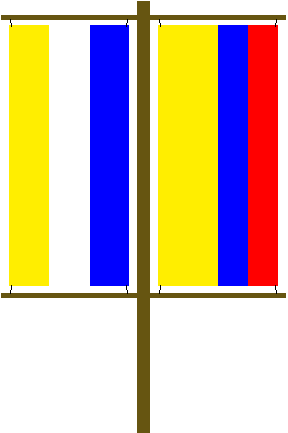
image by Carlos Thompson, 22 July 2003
I was today at my University and it was an interesting display
of flags. On each pole set, they had flying the flags of Colombia
(in the middle), the University (at the viewers left) and the
Vatican (without the charge: plain yellow and white per pale; at
the right). Also, on every mast there was two vertical flags
framed: the University's and the Colombian flag. (Javeriana
flag at viewers left, and top to the left in both flags).
The shade of blue on all those flags was the same shade as the
Colombian flag (some times it seem slightly lighter, but
definitively it was not sky blue).
Carlos Thompson, 22 July 2003
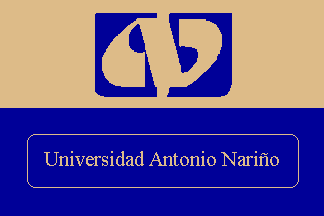
image by Carlos Thompson, 17 March 2003
Universidad Antonio Nariño, Bogota,
Colombia (Antonio Nariño University) - I have not found this in
their website <www.uan.edu.co>,
but I have seen this flag flying over the main door and at the
director's office.
Carlos Thompson, 17 March 2003
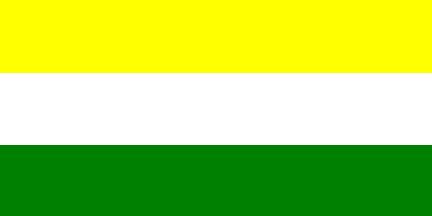
image by Dov Gutterman, 18 August 2002
Image based on <www.uco.edu.co>.
Dov Gutterman, 18 August 2002
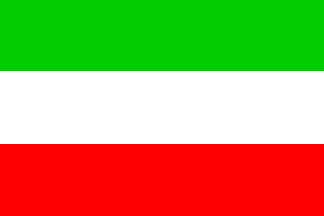
image by Ivan Sache, 16 Febuary 2004
The Colegio Mayor de Cultura Femenina de Cundinamarca was
established by law #45 in 1945. It became an Universitary
institution in 1981 and was granted its current name by law #91
in 1993.
The flag of the institution was prescribed by 'acuerdo' #027 in
1985. It seesm to be horizontally divided green-white-red. The
image on the source quoted below shows the upper strip partially
white, but this must be a mistake. Once again, confirmation of
the true flag design is required.
Source: <www.unicolmayor.edu.co>,
located by Dov Gutterman.
Ivan Sache, 16 Febuary 2004